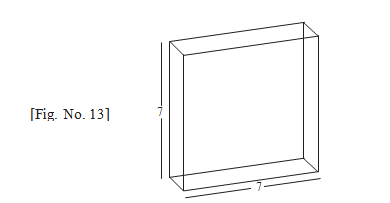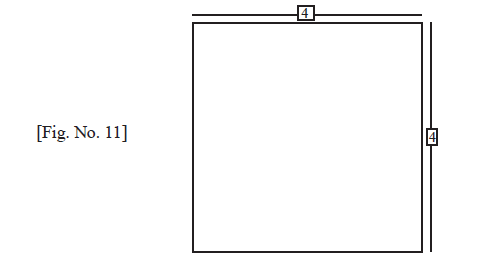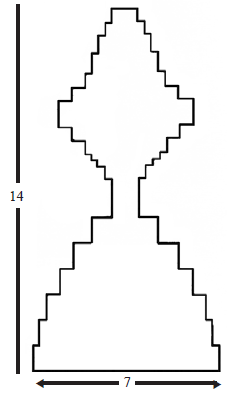The Shvetambara tradition describes the universe in a slightly different way. Although we do not get exact mathematical description of the dimensions (in the āgamas), yet whatever description we get in the later works,[1] we can make it the base of our discussion here. According to the works, the description is as follows:[2] The height of the universe is 14 rajjus; as before. The length and the breadth vary from point to point but are same at the same height. It means that if a horizontal cross-section of the loka is made at any point, it will be a square (see fig. 11).
These are given in terms of khanduka which is the quarter of a rajju. At the lower end, the universe is 28 khaṇḍukas in length and breadth. Then, as the height increases, the length and breadth change. (See fig. 12).
[Fig. No. 12]
In the following table, in the first and second columns, the lengths and the breadths of the universe at the particular heights in terms of khaṇḍukas are given. In the third and fourth columns, the area and volumes are given respectively.
Height from the bottom (in khaṇḍukas)
Length/ Breadth (in khaṇḍukas)
Square (in square khaṇḍukas)
Volume (in cubic khaṇḍukas)
0-4
28
784
3136
4-8
26
676
2704
8-12
24
576
2304
12-16
20
400
1600
16-20
16
256
1024
20-24
10
100
400
24-28
4
16
64
28-30
4
16
32
30-32
6
36
72
32-33
8
64
64
33-34
10
100
100
34-36
12
144
288
36-38
16
256
512
38-40
20
400
800
40-42
20
400
800
42-44
16
256
512
44-46
12
144
288
46-49
10
100
300
49-52
8
64
192
52-54
6
36
72
54-56
4
16
32
Total: 15296
From the above table, it becomes clear that the universe is formed of 56 rectangular parallelepipeds, each having the same height of 1 khanduka (¼ rajju), and varying lengths and breadths. (See fig. 13).

The volume of each parallopiped is obtained by multiplying the height, length and breadth, as shown in the table. The total volume of the universe comes out to be 15296 cubic khandukas.
Now
∴ 1 khanduka = ¼ rajju, and
∴ 1 cubic khanduka = 1/64 cubic rajju
∴ Volume of the universe = 15296 cubic khandukas=cubic rajjus
= 239 cubic rajjus.
This is referred to as the size of ‘vargita loka’.[3] This figure, it seems, does not represent the exact volume of the universe, as the exact volume is stated to be 343 cubic rajjus even in Shvetambara works. For example, in Lokaprakāśa, the author has explicitly mentioned-‘The propounders of metaphysics (tāttvikas) have propounded that there are 343 cubic rajjus of the “ghanīkṛta loka” (cubified universe).[4]
The description given in the Lokaprakāśa[5] to prove that the volume of the ghanīkṛta loka is 343 cubic rajjus does not seem to be precise from mathematical point of view. It seems that the author has tried to create a cubical structure of each dimension equal to 7 rajjus by dismantling the structure which is 14 rajjus in height, but of varying lengths and breadths at different heights. He concludes thus:[6] “The new structure (cubical one) has the length and breadth equal to 6 rajjus plus innumerableth part of one rajju; this can be taken as approximately 7 rajjus. For practical purposes, it is allowed to take a slightly less thing equal to the full one.” Thus, the cube which has the height of 7 rajjus is considered to be formed of length and breadth also to be 7 rajjus, in spite of the fact that they are actually slightly more than 6 rajjus.
The above approximation may be accepted only in approximate calculation, but are unacceptable in precise calculation.
Thus, the actual size of the length and breadth remains enigmatic. This apparent discrepancy deserves critical scrutiny, which we shall undertake in the following topic.
tricatvāriṃśatāḍyāni śatāni triṇi tāttvikaiḥ.. - Lokaprakāśa, 12.137.
rajjavasaṃkheyabhāgāḍhyā bāhulya rajjavo hi ṣaţ.
tathāpi vyavahāreṇa bāhulyaṃ sapta rajjavaḥ.
manyate vyavahāro hi vastunyūne’pi pūrṇatām..
viṣkambhāyāmato’pyevaṃ deśonāṃ spata rajjavaḥ.
vyavahāreṣa vijṣeyāḥ saṇpūrṇā sapta rajjavaḥ.. - Lokaprakāśa, 12.133-135.
 Prof. Muni Mahendra Kumar
Prof. Muni Mahendra Kumar



